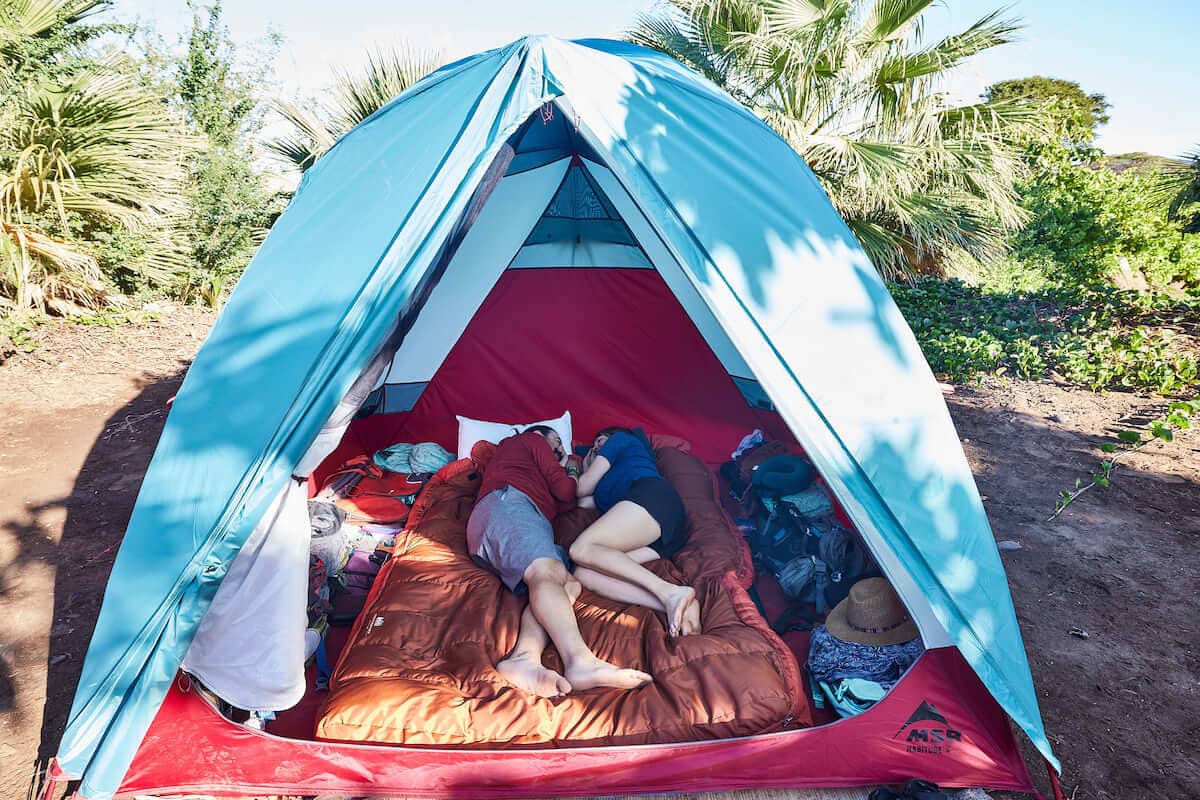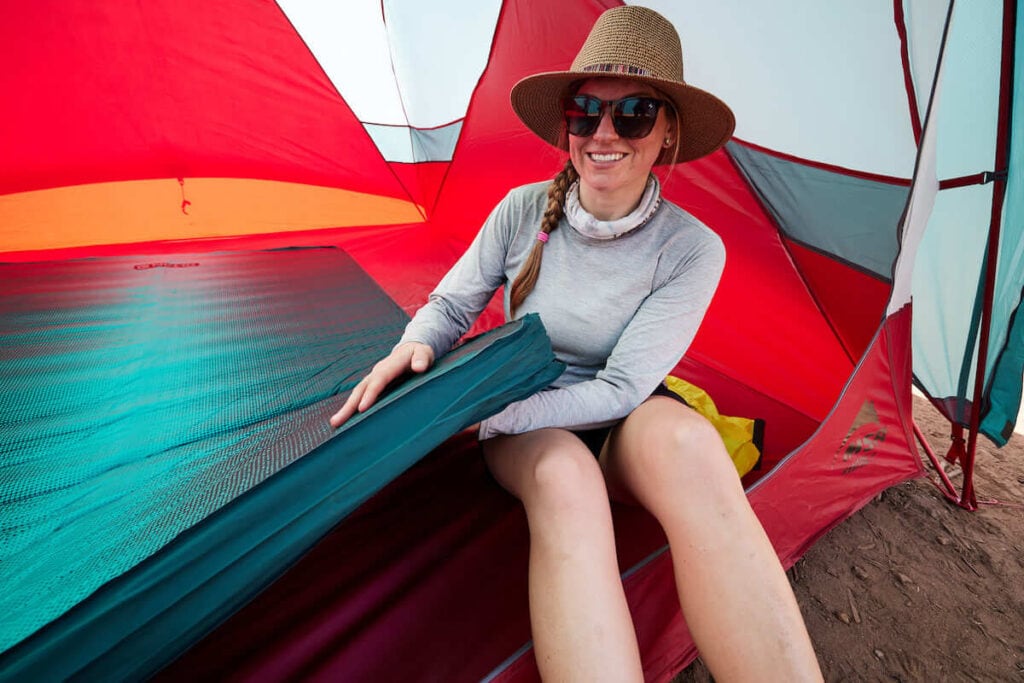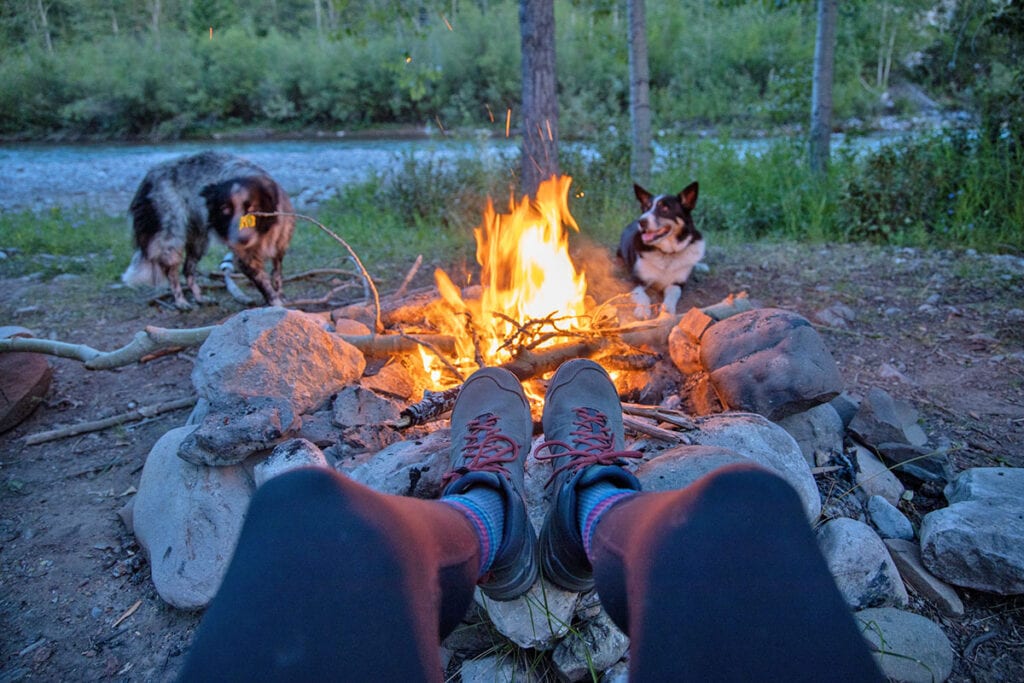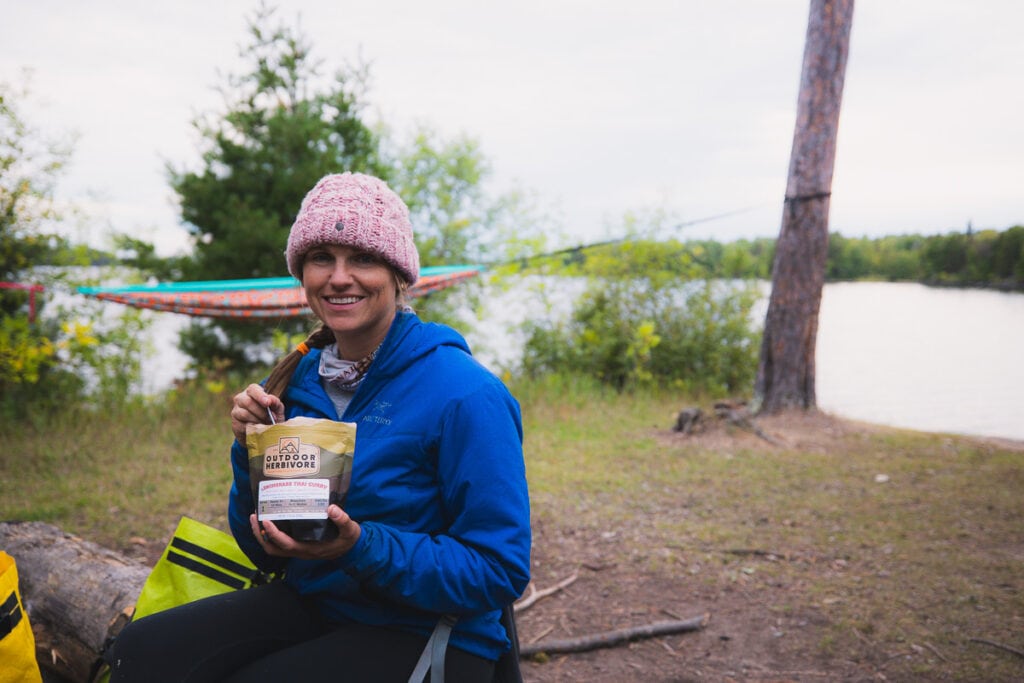18 Tips for Sleeping in a Tent Comfortably (Plus, What Not to Do)
Fed up with tossing and turning in your tent? Here are tips to get more comfortable in your home away from home.

Sleeping comfortably in a tent takes practice. While there’s a world of information about the “best tents” and “best sleeping pads,” the process of sleeping in a tent is very personal. We all have different preferences and some of us just have a harder time getting shuteye outdoors than others. So finding your ideal sleeping system when camping requires trial and error to see what works for you — and what doesn’t.
That said, there are tried-and-true tips that will set you up to get better rest outdoors. For me, it took years, countless camping trips, and hundreds of miles of backpacking (along with establishing rituals at home) to nail down my ideal sleep setup.
And after fine-tuning my system while hiking the John Muir Trail, I now look forward to sleeping in a tent outside. Of course, I’m still adjusting as different things come up like dogs, injuries, and, well, aging. But those wildly wonderful nights under the stars make the extra effort well worth it.
So whether you’re a light sleeper, side sleeper, anxious sleeper, or all of the above , keep reading for 18 tips to make sleeping in a tent more comfortable. Sweet, starry dreams await!
This post may contain affiliate links.
1. Double-check that your camping spot *really* is flat
It’s hard to fall asleep (and stay asleep) when you’re shifting and sliding around throughout the night. So in addition to finding a campsite that meets the principles of Leave No Trace, try to set up your tent in a level area.

I know that this is easier said than done depending on where you’re camping. Even though it’s tempting to settle for a sorta-ish flat spot that’s actually slightly slanted when you’re exhausted, tired of holding your pack, and ready to unwind, it’s worth double-checking that your spot is level.
Beyond eyeballing your campsite, try the water bottle technique – a simple hack that uses a transparent water bottle as a makeshift leveler. Place the mostly-filled water bottle on your desired camping spot horizontally. Is the bubble mostly in the middle? You’ve got a good flat spot!
Save this post!
Enter your email & I'll send this post to your inbox! You'll also receive my weekly newsletter full of helpful advice for planning your adventures.
2. Consider skipping busy campgrounds
Campgrounds can be loud because they’re usually filled with a lot of people. So if you prefer silence at night (insert: hand-raising emoji), large campgrounds could be the least conducive for getting shuteye.
Instead, try finding a nice quiet dispersed site or even a smaller private campground that isn’t quite as crowded as the public ones.
Not sure how to find free campsites? Check out our guide to dispersed camping.
3. Choose your sleeping pad wisely
Sleeping pads essentially act as mini mattresses, getting your body off the ground and helping keep you warm.
When you’re sifting through the many options available, make sure the pad is functional for your situation and sleeping preferences.
If you’re car camping, opting for a thicker pad can help you get a better night’s sleep. If you’re a side sleeper, you’ll want to look for a pad that can handle extra weight in the shoulders and hips.
Looking for sleeping pad recommendations? Here are some of our top picks:

4. Use a foam mat under your sleeping pad
If you’re backpacking and willing to carry a little extra weight, add a foam mat to your pack like the NEMO Switchback Foam Sleeping Pad. When you place it under your sleeping pad, it creates extra insulation, elevates your back even more off the ground, and helps keep your pad in one place.
Beyond providing extra cushion, adding a foam mat under your pad also protects your sleeping pad, so it’s less likely to get poked and ruined by debris (rocks, sticks, etc). This is particularly important on bigger trips when you might not be able to repair your pad on the spot.
A foam mat can also serve as a pad to sit on when you’re cooking dinner and hanging outside your tent at camp.
Tip: Pack Repair Tape
Bring gear repair tape! It’s useful for so many things, including fixing a hole in your sleeping pad should it tear unexpectedly.
5. Invest in a good sleeping bag
Sleeping bags are arguably the most important piece of gear (see our favorite sleeping bags here). They are where you’ll spend at least 8 hours each day of your trip getting much-needed rest and staying warm as temperatures drop.
Temperature rating
Make sure your sleeping bag accommodates the temperatures of wherever you’re going. Something to keep in mind is that the temperature rating of a sleeping bag is an estimate, and if the air temperature drops to the temperature rating of the bag, it doesn’t mean you’ll actually be comfortable.
Instead, for a good night’s sleep in your tent, you’ll want a sleeping bag that’s rated at least 10-20 degrees lower than you expect the outside temperatures to reach.
Sleeping bag length
You’ll also want to make sure the sleeping bag is the right size for your body. Too long and your feet will be cold. Too short and you’ll be scrunched up in there trying to fit.
If you are someone who tosses and turns, you might prefer a backpacking quilt over a mummy bag. A quilt is just as warm and gives you more freedom to move around.

6. Keep your feet warm
If you tend to get cold feet (literally), stash your down jacket down by your feet inside your sleeping bag. Alternatively, a good trick is to boil some water, pour it in a Nalgene water bottle, and throw that in your sleeping bag before you get in.
Read next: If you want to cozy up with your partner, check out the best two-person sleeping bags for camping.
7. Use a pillow
You might be tempted to just stuff some clothes in a sleep sack and call that a pillow. While that’s better than nothing, bringing a camping pillow is a game-changer when sleeping in a tent.
There’s a range of camping pillows designed for camping and backpacking from inflatable to compressible.
Here are the pros and cons of each:
**Overall, I prefer compressible camping pillows for comfort. Even though they take up more space and tend to be slightly heavier, the pros outweigh the cons for me.
If you’re car camping, consider bringing the pillow you normally sleep on to give you a sense of home in the tent.

Side sleepers, you may also benefit from using a knee pillow too (something I learned while pregnant). There are knee pillows designed specifically for travel. You can also double up on camping pillows and get one for your head and one for between your knees. Or you can simply crumple up a soft sweater and stash it between your knees to align your hips.
Read More
Camping Gear Lists
8. Pack a set of cozy (and clean) pajamas
Designate a set of clothes solely for sleeping. For me, that’s a pair of warm leggings, a long-sleeve shirt, and warm socks.
I find the act of putting on a “sleep outfit” helps tell my brain “oh, it’s time for rest now.” It’s also nice to put something on that hasn’t been worn (and sweated in) all day.
9. Cover your ears with a beanie or headband
Ear plugs are always an option to make your surroundings quieter. However, if you want to hear a bit of what’s going on just in case, try sleeping with a soft beanie instead. Beanies work double duty by keeping you warm and drowning out some of the stimuli.

10. Consider upping your tent size
The difference between tossing and turning and sleeping in a tent peacefully may be a few inches of tent space. For example, if you’re camping with another person, consider a 3-person tent rather than just a 2-person tent, especially if you are backpacking with a dog. While a tent may claim to fit two people, that doesn’t necessarily mean it will be comfortable for two people.
I use a 3-person tent because it allows for more space to spread out with my two dogs and my partner Ryan.

11. Use soft lighting
If you like to read before sleeping in a tent or simply want to keep your campsite lit, consider using string lights, a lantern, or a lightweight headlamp that emits softer light, like yellow, orange, or red wavelengths.
These softer lights are overall gentler and less obtrusive on fellow campers compared to blue light or white light.
12. Give yourself time to wind down
Arriving at a campsite and immediately going to sleep doesn’t work for everyone. Even if your body is tired, the adrenaline that comes from moving your body and getting from Point A to Point B can take a while to simmer down.
So when planning your days, it’s usually a good idea to carve out extra time to just be. Maybe this looks like sipping tea by the fire, chatting with a camping buddy while eating a meal, reflecting on your day, or doing simple nightly rituals.
Here are a few ideas for bedtime rituals that can help you wind down for a better night’s sleep in your tent:
Just like the sleep outfit, these little rituals can help you phase into the next chapter of the day.

13. Try a magnesium supplement
Magnesium supplements are thought to promote better sleep and may also help prevent cramping, which is common after a tough day of backpacking. I’ve been taking this mineral for the past few years along with Vitamin D, and slowly but surely feel it’s helped my overall well-being in and out of the tent.
If you’re not interested in supplements, look into packing some magnesium-rich foods instead. NUUN Tablets or SaltStick capsules might also help provide some extra electrolytes and nutrients (including magnesium) you may want after a day spent hiking and sweating.
14. Eat (and drink) enough
There’s nothing worse than lying down to fall asleep only to hear your stomach growl. If you’re on a backpacking trip, make sure you’ve planned ahead and have packed enough yummy backpacking food to keep you fueled and hunger-free.
The same goes for staying hydrated. Dehydration can contribute to poor sleep, so make sure you’re drinking enough water and replenishing your electrolytes.
Read next: New to backpacking? Check out our post on how to plan a backpacking trip in 12 easy steps.

15. Listen to white noise
Outside of my partner and dog, I’ve discovered since having a baby that white noise is my favorite sleep companion. While you may prefer listening to the sounds of nature, if you find that every creak coming out of the woods gives you anxiety or makes you jolt awake, you might find that listening to white noise helps you fall asleep.
Personally, the calming sound helps me enter a relaxed state, drowning out other sounds that would otherwise keep me up. Just be sure to download any sleep sounds in advance so you can play it even without WiFi.
Also, I recommend keeping the volume low, so if there is anything outside that you really do need to be aware of, you can still hear it.
16. Pee when you need to
Before you settle in your tent for the night, make sure you go to the bathroom. It’s irritating to get up in the middle of the night to pee even at home, and it’s especially frustrating when sleeping in a tent. So take a few minutes to get this out of the way, your future self will thank you.
You should also know how and where you’ll go to the bathroom in the middle of the night, so you aren’t stumbling around searching for a tree to duck behind. I like to choose a place that’s within eyeshot of my tent, but far enough away that I’m not peeing right in my campsite. The quicker and easier that midnight trip to pee is the easier it will be to fall back asleep.
Finally, when you get the urge to pee in the middle of the night, just go! Holding it will only disrupt your sleep in the long run.
17. Find ways to manage anxiety
You can have the best gear and find the flattest camping spot and still feel anxious about sleeping in a tent – whether it’s because of the animals or fear of the unknown. It’s common for these anxious thoughts to get especially intense right as you’re settling down in your tent after dark.
Prior to your trip, you’ll want to do a little research on the risks of where you’re going: the animals, the water, the weather, other safety conditions, etc. But give yourself no more than one hour to do so, that way you don’t end up going down a rabbit hole.
Then, when you’re in the tent and notice panic starting to set in, remember you’ve prepared for any potential risks, and you’re ok. From there, you can consider putting on a comforting playlist or practice some mindfulness exercises like gentle body scans, visualization practices, and box breathing.
If it’s permitted, I also pack bear spray to alleviate wildlife fears. So in the unlikely case that I need it… I have it. And I always bring a backcountry communication device (like Garmin inReach Mini 2-Way Satellite Communicator) so I have some sort of communication to help.
18. Get out there, reflect, and repeat
If you had a terrible night’s sleep in a tent, reflect on what wasn’t working. Was the campsite noisy? Maybe venture off further next time or turn on white noise. Did the ground hurt your back? You’d probably benefit from a different sleeping pad and/or sleeping bag. Sometimes solutions aren’t that simple, but sometimes they are!

The important thing is to get out there, listen to your body, and make adjustments over time. While getting advice and testing your gear at home helps, nothing compares to actually sleeping in your tent and using those experiences to make the next ones even better.
3 Things NOT To Do When Sleeping in a Tent
Sometimes it’s the little details that make the biggest difference, whether it’s with gear, backpacking, or, yes, sleeping. So here are a few simple tips on what not to do.
READ NEXT
Preparing for your next camping trip? Here are related blogs to help make camp life more comfortable:
Save this post to Pinterest
What’s your camping bedtime routine? Do you have any tips for sleeping in a tent more comfortably? Let us know in the comments!




